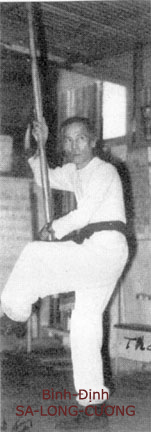II.
THE MEDIEVAL WEAPONS
The Pole-Arms
The Wielding of Pole and Staff
« Côn-Pháp và Roi-Pháp »

 -
- 

Bình-Định is the Region of Martial Arts became celebrious by the « Wielding of War Pole and Battlle Staff Drill ».
A - The « Wielding of War Pole » teaches the use of four kinds of War Poles :
1.- The « Short War Pole - Đoản-Côn », coming up from Middle Finger to Elbow or into Armpit - according to Martial Arts Schools -, and often used by peer, called «Song Côn» (Two Matched Short Pole-Arm ) ;
2.- The « War Pole - Tề-Mi Côn », coming up from ground to Eyebrows ;
3.- The « War Pole - Tề-Mi Côn », coming up from ground to Eyebrows ;
4.- The « Long War Pole - Trường-Côn », coming up from ground to level of Hand pointed toward the sky.
B - The « Wielding of Battle Staff Drill » teaches the use of two kinds of Pole-Arm :
1.- The « Short Battle Staff Drill - Roi-Đoản (Đoản-Tiên) » ;
2.- The « Long Battle Staff Drill - Roi-Trường (Trường-Tiên) »
.
It exists Three categories of War Pole and Battle Staff wielding :
a. Those of Wielding for Combat (Roi Đấu) ;
b. Those of Wielding for War (Roi Chiến) ;
c. Those of Wielding for ranged Battles (Roi Trận).
In the Wielding of « War Pole-Arm » and « Battle Staff Drill », according to Traditional Martial Arts from Bình-Định, it exists 10 distinct ways to use the Pole-Arm and the Staff Drill, called « The Ten Lunges "Phách" of Staff Drill » : 1 - To Bear to Starboard (Bát) ; 2 - To Arrest (Bắt) ; 3 - To Destroy (Triệt) ; 4 - To Block (Chận) ; 5 - To Pass Through (Hoành) ; 6 - To Fend Off (Khắc) ; 7 - To Shake (Lắc) ; 8 - To Gather (Tém) ; 9 - To Strike (Đánh) ; 10 - To Pierce (Đâm).
These Ten Lunges "Phách" of War Pole-Arm and Battle Staff Drill are organized in Three groups :
1. To Bear to Starboard (Bát), To Arrest (Bắt), To Shake (Lắc), To Strike (Đánh) ;
2. To Arrest (Bắt), To Bear to Starboard (Bát), To Destroy (Triệt), To Block (Chận) ;
3. To Pass Through (Hoành), To Fend Off (Khắc), To Shake (Lắc), To Gather (Tém).
However, according to Traditional Martial Arts of Battlefields, the listing and the definition of these Ten ways to wield the Pole-Arm and the Staff Drill are manifestly different because it belongs to War Pole and Battle Staft Wielding applied to Ranged Battles according to the Medieval Military Tactics.
Committee of TRỊNH Quang Thắng. |
The Codified Sequence of
« Pole of Mountain Thái »
(Thái-Sơn Côn)

The Grand-Master Trương-Thanh-Đăng
presenting the Codified Sequence of
« Pole of Mountain Thái »
(Thái-Sơn-Côn)
The foundamental Codified Sequence of the War Pole wielding in our SA-LONG-CƯƠNG School System is the one's of « Pole of Mountain Thái - Thái-Sơn-Côn », celebrious of Traditional Martial Arts of Bình-Định and have been passed down to our Grand-Master Trương-Thanh-Đăng by the Master of great renown Trương-Trạch.
As it's about a Codified Sequence of Pole wielding combining with the one's of Staff ; it's still called Codified Sequence of « Staff of Mountain Thái - "Roi" Thái-Sơn ».
This Codified Sequence « Thái-Sơn-Côn », belonging to those of Long War Pole wielding, owns 12 Heptametric Coded Lines of Verse (84 characters), including the « Ten Passes "Phách" of Battle Staff ». And it's still clearly explained through out the « Martial Canto of Long Battle Staff Drill in National Language - Trường-Côn Diễn Quốc-Âm Ca » composed by TRƯƠNG family, with 41 coded Hexamétriques et Octométriques lines of verse, 288 words.
(To be continued...)
Committee of TRỊNH Quang Thắng. |
Copyright © 2004 - 2017 by ACFDV - All rights reserved.
